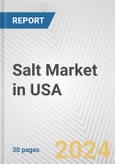The report includes not just high-quality tables and figures but also a detailed textual content which all together give a true insight into the national market for Salt.
Report Scope
- The report considers present situation, historical background and forecast of Salt market in USA
- Comprehensive data on Salt supply/demand, trade statistics, and prices in the recent years is provided in the report
- The report gives information about Salt market players in USA
- Salt market forecast for the next five years, including market volumes and prices is also included:
- What were the main trends of USA Salt market in 2019-2024?
- What was the size of the USA Salt market in 2019-2024?
- What was USA Salt supply in 2019-2024?
- What are the main players in USA Salt market?
- What drivers and challenges will determine the development of USA Salt market in 2025-2029?
- What will be the CAGRs for USA Salt supply and demand?
- Are there Salt projects to be completed in 2025-2029 in USA?
- And many others
This product will be delivered within 3-5 business days.
Table of Contents
1. Overview of Salt Market in USA2. Reserves in USA
2.1. Reserves Estimation
3. Salt Supply in USA
3.1. USA Production in 2019-2024
3.2. USA Production Shares in Global Market and in Regional Market in 2019-2024
4. Salt Demand in USA
5.1. Demand Structure, 2024
5.2. USA Consumption in 2019-2024
5. Salt Trade in USA
5.1. Export (Recent Years)
6.2. Import (Recent Years)
6.3. Annual Prices (Recent Years)
6. Salt Market Forecast to 2029
6.1. General Market Forecast
6.2. Salt Production Forecast to 2029
6.3. Salt Consumption Forecast to 2029
7. Salt End-users in USA
List of Tables
- Salt Production in USA in 2019-2024
- USA Production Share Globally in 2019-2024
- USA Production Share in Region in 2019-2024
- Salt Demand Structure, 2024
- Salt Demand Dynamics in USA in 2019-2024
- Trade in USA in Recent Years
- Structure of Export by Country in Recent Years
- Structure of Import by Country in Recent Years
- Export and Import Prices in USA in Recent Years
- Production Forecast to 2029
- Demand Forecast to 2029








